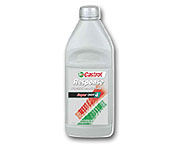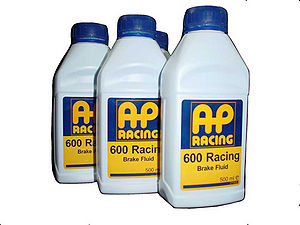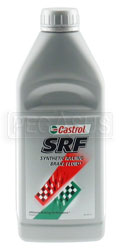Difference between revisions of "Brake fluid"
hbaumhardt (talk | contribs) |
hbaumhardt (talk | contribs) |
||
| Line 9: | Line 9: | ||
[[Image:AP600 Brake Fluid.jpg|thumb|left]] | [[Image:AP600 Brake Fluid.jpg|thumb|left]] | ||
| − | The dry boiling point is the temperature at which a given brake fluid | + | The dry boiling point is the temperature at which a given brake fluid boils when it is fresh out of the can. Since DOT 4, and DOT 5.1 brake fluids are hygroscopic and adsorb water over time (through the breathers, caliper piston seals and by magic) which boils at 100 °C, the absorbed water dramatically lowers the boiling point of the brake fluid. The Wet boiling point is the temperature at which a given brake fluid boils when it has taken on 3.7% H2O. For detailed discussion checkout http://www.stoptech.com/tech_info/wp_brakefluid_1a.shtml |
| + | |||
| + | |||
| + | |||
Notes from a 20 track day (45 track hours) a year Elise; | Notes from a 20 track day (45 track hours) a year Elise; | ||
| Line 15: | Line 18: | ||
• '''Comma DOT5.1''' £8/lit (Dry 280°C Wet 180°C). Hmmm. | • '''Comma DOT5.1''' £8/lit (Dry 280°C Wet 180°C). Hmmm. | ||
| − | • '''Castrol Response Super DOT 4''' £10/lit (Dry 280°C Wet 186°C). This was needing to be changed every 6 track hours with a gradually softening pedal | + | • '''Castrol Response Super DOT 4''' £10/lit (Dry 280°C Wet 186°C). This was needing to be changed every 6 track hours with a gradually softening pedal, coming out black from the front calipers and discoloured from the rear. |
| − | • '''AP600''' £20/lit (Dry 310°C Wet 210°C). This seems to want 50ml bled off the front calipers every 6 track hours (no noticeable colour change) which effectively | + | • '''AP600''' £20/lit (Dry 310°C Wet 210°C). This seems to want 50ml bled off the front calipers every 6 track hours (no noticeable colour change) which will effectively purge the system every year (but don't forget to do the rears and clutch). |
• '''Castrol SRF''' £50/lit (Dry 310/Wet 270°C) This is in a class by itself with patented chemistry providing wet boiling point close to most other fluids dry. Not affluent enough to try this. | • '''Castrol SRF''' £50/lit (Dry 310/Wet 270°C) This is in a class by itself with patented chemistry providing wet boiling point close to most other fluids dry. Not affluent enough to try this. | ||
| Line 28: | Line 31: | ||
It is possible to change the brake fluid yourself but '''need article writing'''. | It is possible to change the brake fluid yourself but '''need article writing'''. | ||
{{clr}} | {{clr}} | ||
| − | |||
| − | |||
| − | |||
| − | |||
| − | |||
| − | |||
| − | |||
| − | |||
| − | |||
[[Category:Brakes]] | [[Category:Brakes]] | ||
Revision as of 20:45, 28 September 2006
Lotus specify Castrol Super DOT 4 brake fluid changed annually. This is a fully synthetic brake fluid that exceeds the boiling point specifications of most DOT 5.1 fluids and is no more costly and for road use this is fine.
Hard track use with extended high temperatures over 30 minute sessions needs some further consideration; regular change of less expensive fluid or more expensive race fluid changed less ? There is no right answer.
The function of brake fluid is to provide an incompressible medium to transmit the driver’s foot pressure to clamp the friction material against the discs. When fresh, all brake fluids are virtually incompressible, but overheated brake fluid will boil in the caliper producing gas bubbles which are compressible leading to a “soft” brake pedal with long travel.
The dry boiling point is the temperature at which a given brake fluid boils when it is fresh out of the can. Since DOT 4, and DOT 5.1 brake fluids are hygroscopic and adsorb water over time (through the breathers, caliper piston seals and by magic) which boils at 100 °C, the absorbed water dramatically lowers the boiling point of the brake fluid. The Wet boiling point is the temperature at which a given brake fluid boils when it has taken on 3.7% H2O. For detailed discussion checkout http://www.stoptech.com/tech_info/wp_brakefluid_1a.shtml
Notes from a 20 track day (45 track hours) a year Elise;
• Comma DOT5.1 £8/lit (Dry 280°C Wet 180°C). Hmmm.
• Castrol Response Super DOT 4 £10/lit (Dry 280°C Wet 186°C). This was needing to be changed every 6 track hours with a gradually softening pedal, coming out black from the front calipers and discoloured from the rear.
• AP600 £20/lit (Dry 310°C Wet 210°C). This seems to want 50ml bled off the front calipers every 6 track hours (no noticeable colour change) which will effectively purge the system every year (but don't forget to do the rears and clutch).
• Castrol SRF £50/lit (Dry 310/Wet 270°C) This is in a class by itself with patented chemistry providing wet boiling point close to most other fluids dry. Not affluent enough to try this.
Brake bleeding. Order; OSR, NSR, OSF, NSF. Wheels off for the rears, but can do it through the spokes at the front. For each caliper in turn, pump the brake pedal until it is solid then maintain the pressure whilst the other person puts a non return value on the brake nipple and releases it (11 mm spanner) until the pedal hits the deck.
It is possible to change the brake fluid yourself but need article writing.


